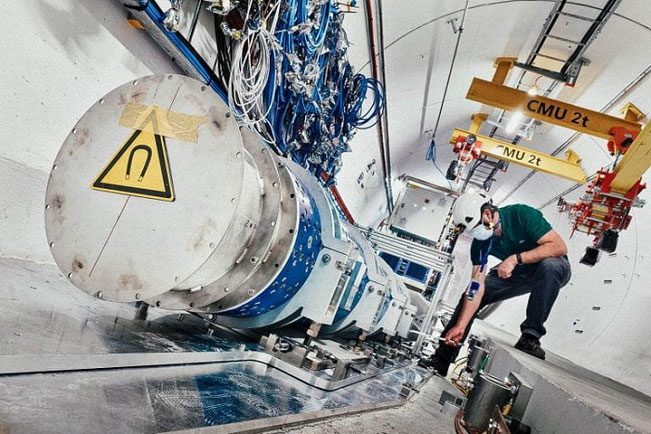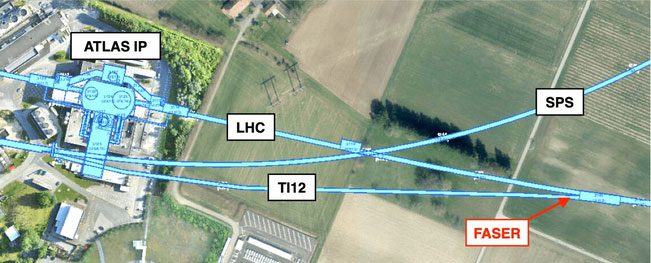The Forward Search Experiment (FASER) group, led by physicists at the University of California, Irvine, has successfully detected neutrino candidates for the first time at the Large Hadron Collider (LHC) located at CERN near Geneva, Switzerland.

In a publication in the journal Physical Review D, the researchers described how they observed six neutrino interactions in an experiment conducted using a compact emulsion detector installed at the LHC in 2018.
“Before this project, no signals of neutrinos had ever been detected at a particle accelerator,” said co-author Jonathan Feng, an astrophysics professor at UCI and co-leader of the FASER collaboration. “This significant breakthrough is a step towards a deeper understanding of these elusive particles and their role in the universe.”
He mentioned that this discovery provided two key pieces of information during the experiment. “First, it confirms that the ATLAS interaction point is indeed the right location for detecting neutrinos,” Feng noted. “Second, our efforts demonstrate the effectiveness of using emulsion detectors to observe such neutrino interactions.”
The experimental device was constructed using layers of lead and tungsten interspersed with emulsion layers. During particle collisions at the LHC, some neutrinos caused interactions with nuclei in the metals, resulting in particles that traveled through the emulsion layers and created detectable tracks during processing. These tracks provide clues about the energy of the particles, their types—tau, muon, or electron—and whether they are neutrinos or antineutrinos.
According to Feng, the emulsion was “repurposed” similarly to how photographic techniques were used before the digital camera era. When a 35-millimeter film is exposed, photons leave behind patterns. The FASER researchers were able to observe neutrino interactions after developing the emulsion layers in the detector.

The FASER experiment is located 480 meters from the ATLAS installation at the LHC. According to Jonathan Feng, this is a reasonable site for neutrino detection, resulting from particle collisions at the LHC. (Source: CERN)
“To achieve efficiency from this emulsion detector approach to observe neutrino interactions produced at a particle accelerator, the FASER team is currently preparing a series of new experiments with an upgraded device that is not only larger but also significantly more sensitive,” Feng stated.
Since 2019, he and his colleagues have been ready to conduct an experiment with FASER’s tools to investigate dark matter at the LHC. They hope to detect dark photons, which could provide researchers with the first opportunity to observe how dark matter interacts with ordinary atoms and other materials in the universe through non-gravitational forces.
With the success of their neutrino work in recent years, the FASER team—comprising 76 physicists from 21 research institutions across nine countries—is integrating a new emulsion detector with FASER’s machinery. While the experimental detector weighs around 64 pounds, the FASERnu device will weigh over 2,400 pounds, and it will enhance the response and capability to distinguish between neutrino types.
“With the right detector and location at CERN, we anticipate recording over 10,000 neutrino interactions in the new experiment at the LHC, starting in 2022,” said co-author David Casper, co-leader of the FASER project and an associate professor of physics and astronomy at UCI. “We will detect the highest energy neutrinos ever produced from a human-made source.”
What makes FASERnu unique, he explained, is that while other experiments can distinguish between two or three types of neutrinos, it will be able to observe all three types plus their antiparticles—antineutrinos. Casper noted that historically, tau neutrinos have only been observed about ten times, but he hopes his team can double or triple that number in the next few years.
“This represents a wonderful connection to the tradition at the UCI Department of Physics,” Feng remarked, “because it seamlessly aligns with the legacy of Frederick Reines, a founding faculty member at UCI who won the Nobel Prize in Physics for the discovery of the neutrino.”
“We have conducted a world-class experiment at the world’s leading particle physics laboratory in record time and with non-traditional funding sources,” Casper said. “We have received substantial funding from the Heising-Simons Foundation, the Simons Foundation, as well as the Japan Society for the Promotion of Science and CERN.”
Savannah Shively and Jason Arakawa, UCI physics and astronomy graduate students, also contributed to this work.





















































